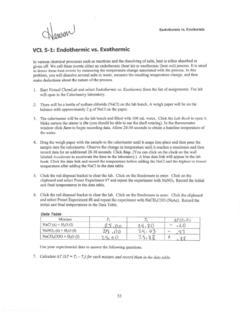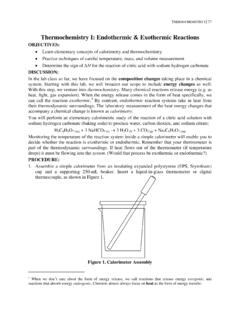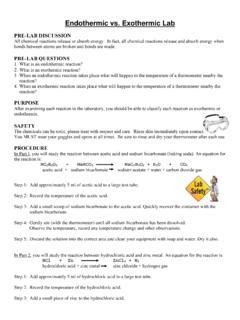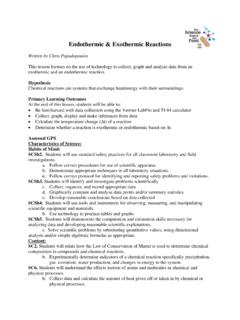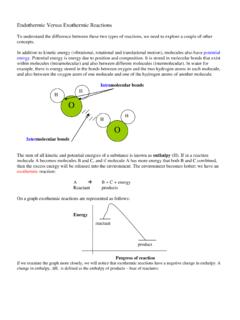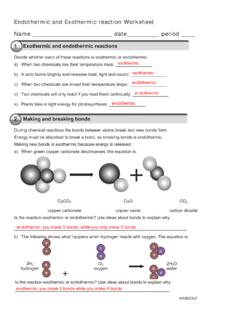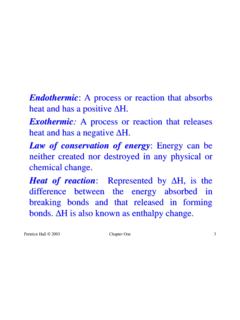Transcription of Module Overview Curriculum Links 1.2.A 1.2
1 Energetic reactions : Ice Cream Experiment Teacher Guide Module Overview Heat transfer is an important part of many chemical reactions , but it is often not directly observed. In this Module students conduct an experiment making homemade ice cream that requires heat transfer to occur. Students measure temperatures and observe states of matter throughout the experiment in order to draw qualitative conclusions about the direction and amount of energy transfer that occurs in the reaction. Additionally, students are introduced to colligative properties as they manipulate freezing point of water in order to facilitate the reaction. At the end of the experiment, students get to do something not usually done in chemistry labs eat the product of the reaction! Curriculum Links Forms of energy have a source, a means of transfer (work and heat), and a receiver Energy can be transferred within a system as the total amount of energy remains constant ( Law of Conservation of Energy) Scientific inquiry includes relies upon gathering evidence from qualitative and quantitative observations Goals 1.
2 To understand exothermic and endothermic reactions . 2. To understand the transfer of energy within a system. 3. To understand colligative properties and the effect of salt on freezing point of water. Timing This Module takes 1 to 2 hours to complete. DVD Included in this kit is an informational DVD. It is meant to demonstrate the demos described below and provide some hints to make the experiments run more smoothly. It will also go over the background information in attempts to provide a starting point/suggestions for communicating the pertinent background information to your students. Kit Materials Included by The Young Scientist Program: Sugar Vanilla Salt Ziploc Bags Thermometer Measuring Cups/Spoons Scissors Plastic Cups/Spoons Materials Supplied by Teacher: Whole Milk Heavy whipping cream Additional ice cream toppings if desired Energetic reactions : Ice Cream Experiment Teacher Guide Lesson Design Tool Course: Teacher: Week of: Grade Level: CONTENT AREA: DIFFERENTIATED INSTRUCTION/CROSS CONTENT INTEGRATION Goals: Big Idea/Concept HOW will you teach the Content?
3 (groups, strategies, accommodations, content variation,etc.) To understand exothermic and endothermic reactions . To understand the transfer of energy within a system. To understand colligative properties and the effect of salt on freezing point of water. Student handouts covered in large group. Small work in small groups to complete experiment. Students discuss and respond to questions on handout during experiment. Grade Level Expectation/Objective: (WHAT are you going to teach?) Forms of energy have a source, a means of transfer (work and heat), and a receiver Energy can be transferred within a system as the total amount of energy remains constant ( Law of Conservation of Energy) Scientific inquiry includes relies upon gathering evidence from qualitative and quantitative observations Essential Questions(s)/DOK: Higher Order Questions (scaffolded questions to get to Big Idea) Why is salt put on icy roads during the winter?
4 What is the difference between endothermic and exothermic reactions ? How is energy transferred within the system when making ice cream? Assessment/Performance Task: How will students SHOW what they have learned? Teacher Reflections/Student Work Analysis Demonstrate understanding during experiments. Responses on handout/discussion questions. Vocabulary Vocabulary Strategies Reteaching Strategies exothermic Reaction endothermic Reaction Colligative Properties Solute/Solvent Technology/Manipulatives Energetic reactions : Ice Cream Experiment Teacher Guide Background Energy of Chemical reactions Chemical reactions occur when two or more molecules interact and change. When molecules undergo chemical changes, they may absorb or release energy from the environment. reactions that release energy as heat, light, or sound are called exothermic reactions .
5 reactions that absorb energy are called endothermic reactions . If chemicals gain or lose enough heat during a reaction, they may change state. Solids have the lowest amount of energy and their molecules are arranged in an organized lattice. As heat is added to a solid, the molecules begin to move more freely. Eventually the solid melts into a liquid and then the liquid vaporizes to become a gas. The diagram at the right shows these changes graphically. In this experiment we will combine ice cream ingredients and put them in a cold environment to facilitate the reaction and freezing process that turns the raw ingredients into ice cream. At home we often put things in the freezer to make them cold and we turn a dial to control the temperature. Today we will use ice cubes to create the cold environment and we will control the freezing temperature by taking advantage of colligative properties.
6 Colligative Properties A solution is a mixture of two or more substances formed when a solute (minor substance) is dissolved in a solvent (major substance, like water). Dissolving a solute in a solvent changes some physical properties of the solvent like the freezing point and boiling point. These are called colligative properties and the amount they change depends on the total concentration of solute particles, but not the identity of those particles. Today we will use the effect of a solute (salt) on the freezing point of a solvent (water) to help our ice cream reaction. References and Further Information Scientific American Why do we put salt on icy sidewalks in the winter? How Stuff Works Why do they use salt to melt ice on the road in the winter? Energetic reactions : Ice Cream Experiment Teacher Guide Materials Each group of students needs: 3 Tablespoons of sugar 1/2 cup of whole milk 1/2 cup of heavy whipping cream 1/4 teaspoon of vanilla 3/4 cup of salt (rock salt works best, but table salt works too) 3 cups of ice cubes (enough to half fill the gallon Ziploc) 1-quart Ziploc bag (Note: use freezer-safe Ziplocs if possible for stronger seal) 1-gallon Ziploc bag Thermometer Measuring cups and spoons (these could be made by pre-marking lines on disposable cups) Additional materials needed for the class Scissors Plastic cups and plastic spoons (one per student) Additional ice cream toppings as desired Safety 1.
7 Ensure no students have allergies to the food ingredients (ex. lactose intolerance) 2. Students should wash their hands before beginning the lab. Protocol Students should work in groups of 2 Small Bag (1 quart Ziploc bag) 1. Add 3 Tablespoons of sugar to the small ziplock bag. 2. Pour in cup of whole milk. 3. Pour in cup of heavy whipping cream. 4. Add teaspoon of vanilla. 5. Close the bag VERY tightly (otherwise salt and ice will leak in later on yuck!). Optional: double-bag the small bag for extra protection. Take a moment to observe the appearance of the ingredients at this initial stage. Be sure to consider the color, state of matter, and homogeneity. Record your observations below. Big Bag (1 gallon Ziploc bag) 6. Pour ice (about 3 cups) into the big ziplock bag to half-fill the bag. 7. Use the thermometer to measure the temperature of the ice.
8 Record the temperature below. 8. Add cup of salt into the big bag. Freezing 9. Put the small bag (the one with the milk, sugar, and vanilla) into the big bag. Again, make sure the small bag stays closed so nothing leaks in). There should be enough ice in the big bag that the small bag is well surrounded. Squeeze the extra air out from the big bag and close it tightly. Double check that this seal is tight! 10. Rock the gallon bag from side to side. Trade off with your partner so that your hands don t get too cold. Continue to rock the bag for 10-15 minutes. Record any changes that occur in the bag. Energetic reactions : Ice Cream Experiment Teacher Guide While you are mixing, predict what you think will happen to the ice and salt in the big bag. How will appearance change? Will temperature change? If so, will it increase or decrease?
9 By how much? Why do you think that? Record your predictions below. 11. Once the ice cream has solidified, open the big bag and use the thermometer to measure the temperature of the ice/salt mixture. Record the temperature below. 12. Remove the small bag, cut off a corner, and squeeze the ice cream into an individual cups (one per student). 13. Serve with spoons and enjoy!! Helpful Tips Use freezer-safe Ziploc bags if available. The seals on these bags are tighter which helps prevent the inner bag from breaking open as the students agitate the bags during freezing process. If strong Ziplocs are not available, double-bag the inner bag for added protection. Be patient during the freezing process. It should take more than 10 minutes before solidification. The bag gets very cold; students should take turns agitating it.
10 Students may use paper towels, hand towels, gloves, or sweatshirts to hold them hold the bag during agitation. Optional Variation For a longer version of this experiment, assign each group of students to one of three conditions: no salt, regular salt (3/4 cup), or high salt (2 cups). Have each group of students use that amount of salt in their outer bag. Students should time and record how long they rock the bag before their ice cream forms. Record the results on the board and discuss together as a class. Students should discover that the more salt that is present, the faster the ice cream will form. The ice of the no salt groups will not be cold enough and therefore the ice cream will not solidify. As the other groups finish forming their ice cream and take it out to serve, the no salt groups may add salt to their large bags and complete the experiment so that they too can enjoy the delicious treat.

